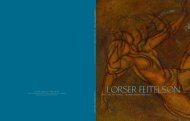helen lundeberg - Louis Stern Fine Arts
helen lundeberg - Louis Stern Fine Arts
helen lundeberg - Louis Stern Fine Arts
You also want an ePaper? Increase the reach of your titles
YUMPU automatically turns print PDFs into web optimized ePapers that Google loves.
<strong>helen</strong> <strong>lundeberg</strong>: without whom . . .<br />
It is a standard reflex to think about American art in<br />
terms of generations. As a consequence, Helen Lundeberg<br />
and her contemporaries (most notably Karl Benjamin, Lorser<br />
Feitelson, Frederick Hammersley, June Harwood and John<br />
McLaughlin) are most often compared to their East Coast<br />
contemporaries: the post-painterly abstractionists (Helen<br />
Frankenthaler, Morris <strong>Louis</strong> et. al.). For myself, I have<br />
always found comparing Lundeberg and her contemporaries<br />
with the New York School painters of the previous generation<br />
to be more rewarding—for two reasons. First, the painting<br />
of Lundeberg and her contemporaries informs subsequent<br />
art practice on the West Coast in much the same way that<br />
New York School painting informs subsequent practice on<br />
the East. Their presence is indisputable and unavoidable.<br />
Their painting must be acknowledged or repudiated by those<br />
who follow, must function as a touchstone or an icon of<br />
rebellion. As a consequence, artists as disparate as Robert<br />
Irwin, Edward Ruscha, Peter Alexander and Mike Kelley owe<br />
Lundeberg and her contemporaries an inestimable debt.<br />
The second reason for considering New York School<br />
Painting in comparison with what we now call California<br />
Hard Edge Painting is that both practices make what I<br />
would consider to be a democratic accommodation to the<br />
conventions of genteel surrealism that pervaded European<br />
and American art in the years before, during and after World<br />
War Two. That surrealism posited an internal landscape<br />
adorned with pictures and portrayals—a symbolic Freudian<br />
atmosphere at once withholding and redolent with occasions<br />
for interpretation. The painters of the New York School<br />
would dissolve this atmosphere into a field of microscopic<br />
subjectivity—at once too externally generalized and too<br />
internally specified to yield the sort of interpretive frisson<br />
to which European Surrealism aspired. Lundeberg and<br />
her contemporaries on the West Coast would suppress all<br />
idioms of subjectivity, abstract and externalize that surrealist<br />
landscape into a code that spoke simultaneously of an<br />
internal and external condition of being. In both cases this<br />
instinct was to create an inclusive image that existed at a<br />
level of generalization which excluded no one and to which a<br />
wide populace might respond.<br />
Dave Hickey<br />
Of all these California painters, Helen Lundeberg was<br />
by far the most elusive and charming. Her transition from<br />
“ classical surrealism” to hard-edged painting was the<br />
most infinitely gradated and her palate the most subtle and<br />
pictorially evocative. The reason for this, I suspect, is that<br />
Lundeberg, like Mark Rothko on the other coast, never really<br />
“broke” with surrealism into the realm of pure abstraction<br />
and never abandoned the latent atmospherics of its interior<br />
landscape. This landscape remains present in Lundeberg’s<br />
work, even as it rises into flat abstraction, even as it echoes<br />
and leaks into the actual atmosphere and actual landscape<br />
in which she lived and worked. It is this phenomenological<br />
overlay of passionate seeing and that which is seen, of<br />
interior and exterior atmospherics that defines Robert<br />
Irwin’s and Edward Ruscha’s debt to Lundeberg, and this<br />
debt is grounded, I think, in Lundeberg’s ability to purify<br />
her imagery without reducing it, to rarify the atmosphere of<br />
her paintings without discarding anything that was already<br />
there. Thus, for all their rigor and impersonality, Helen<br />
Lundeberg’s paintings are still full of dreams.<br />
Dave Hickey is a writer and critic who<br />
lives in Long Beach, California.<br />
10 11





